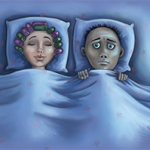The protocol for CBT for JFM includes relaxation training, distraction techniques, activity pacing, cognitive techniques such as calming statements, and problem solving. As part of the protocol, parents should be coached in how to support the patient’s efforts, Dr. Kashikar-Zuck said. It’s also important to provide patients with the rationale for the behavioral techniques. Dr. Kashikar-Zuck discusses the “pain gate” in an age-appropriate way to her adolescent patients.
In a small study of 30 patients led by Dr. Kashikar-Zuck, patients were randomly assigned to eight weeks of CBT or self-monitoring.1 Functional disability scores declined by 38.8% overall. Other studies also showed positive results.
Recently, Dr. Kashikar-Zuck decided to test the thesis further by comparing eight weeks of CBT to eight weeks of one-to-one fibromyalgia education from a therapist. During the session at the ACR meeting, Dr. Kashikar-Zuck presented preliminary results of the randomized, blinded study of 114 children and adolescents. Patients receiving CBT showed an improvement of nearly 40% in Functional Disability Inventory scores at a six-month follow-up visit compared with about a 10% improvement for patients receiving fibromyalgia education alone. Scores in the children’s depression inventory improved 35% with CBT, compared with about 25% for the education group.
Reduction in pain from CBT was small but significant. While pain reduction is not a primary objective of CBT, Dr. Kashikar-Zuck found it encouraging that the treatment could improve functioning and increase activity without any increase in pain. “The general trend is for parents to say, ‘My child will start doing things as soon as the pain gets better.’ My reaction is to say, We’re going to do things the other way [around]. We’re going to have your child start doing things first and allow the pain to get better. We don’t want to let her life to start falling apart while we wait for the pain to go away.”
The path to wellness for these adolescents starts with a physician who feels comfortable dealing with chronic pain, Dr. Kashikar-Zuck told the audience. “Patients are going to come in and see their physician first. If they feel a sense of discomfort, rejection or abandonment, you’ve already set up a situation where they’re not going to respond well to treatment. Remember, these patients have usually been through the wringer before they ever get to you. So if it is possible to listen, and to speak to them in a reassuring way, and give the impression you’re able to understand and at least tell them what is known in an honest way, and let them know what you can and can’t do for them, patients will engage. And it is our goal to engage early, when they’re adolescents. Because all the research we’re doing shows this is something that can and should be managed early—and when left untreated can essentially lead to some long-term problems.”
